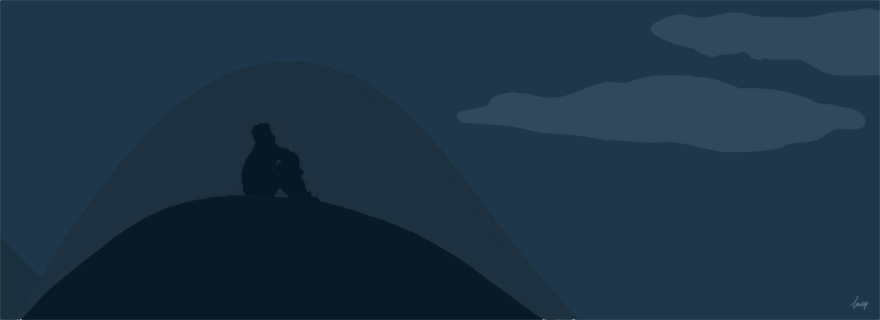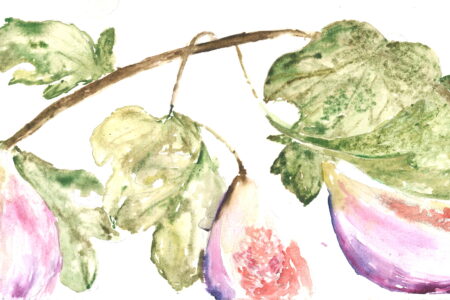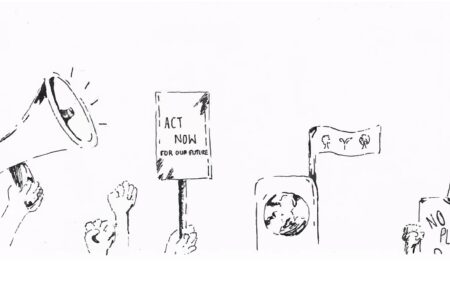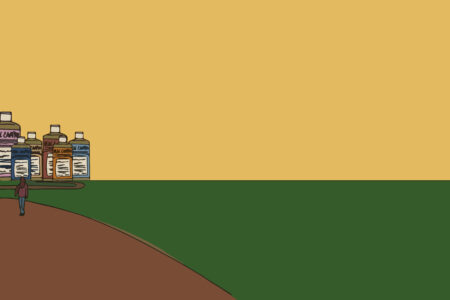The Transcendence of Fear to Love
It was a scorching August afternoon in California. I was sitting in the car with my family, driving up Highway 5 from San Diego to Berkeley. Even with the air conditioning blasting at full power, I still felt the sun rays burning through the car window. However, the sweat on my skin was the least of my concerns. My mind was preoccupied with all of the terrifying sights we were passing: angry, hand-made posters on the road saying things like “Lake Mead is Dry”. Dry, brittle shrubbery that screamed fire hazard, followed by blackened, fire licked trees which confirmed my concerns. Overcrowded herds of pained-looking cows who I knew were emitting clouds of methane; thick smog emitted by passing long-haul truckers and the many signs on the road which read “SEVERE DROUGHT. HELP SAVE WATER”. To make matters worse, I had a news podcast blaring in my Air Pods, warning me that if we don’t stop using fossil fuels, the damage to the planet will be “irreversible” and “unsolvable.”
I loved growing up in Southern California. The jagged coastlines, sparkling waters, and eternal sunshine never ceased to amaze me. Each time I return home, I’m greeted and amazed by the immense natural beauty.
But fear began to overtake love when driving on that Southern California freeway. While I have seen many scary effects of climate change with my own two eyes, most of my concrete knowledge — on which I based my opinions and thoughts — came from the media, like that aforementioned podcast. The media plays a large role in drawing our awareness to these frightening circumstances, and many people rely on it as their main source of information and education. It seems almost impossible not to be frightened when our entire world is on course to mirroring an apocalyptic horror movie. I feel the fear in my bones and I feel love and joy surge through my body when I’m in nature. They are equal emotions. But I am determined to have that love transcend fear.
We've all heard the scary facts and figures:
“Climate change could be irreversible by 2030”.
“Our carbon emissions are burning through our ozone layer”.
We’ve seen the devastating images online:
Cows packed like sardines into tiny, dirty sheds.
Landfills filled with thousands of pieces of discarded trash and clothes.
Islands of colorful plastic in the ocean, usually followed by images of sea life choking on it.
We’ve watched the documentaries and captivatingly chilling docu-series on Netflix.
We’ve heard politicians from both ends of the spectrum debate the “climate crisis” all over the world.
This propaganda fills our social media and TV. It occupies many of our conversations and our personal thoughts. These messages all intend to make us believe one thing – climate change is very real, and if we do nothing about it, we’re all going to die a painful and imminent death.
While there is truth to this, as I saw with my own eyes on my road trip up to Berkely, and while it is undoubtedly important to portray, I believe there is a fault in this fear-focused approach.
There are two issues with this aggressive strategy. The first is that it puts blame on the individual. While individuals can change their behaviours (which, if we all come together as a human race to act more sustainably, we will see major changes), the bulk of the change must be initiated by governments and large corporations in order to seriously stop global warming (but that is a conversation for a different time). The second, and the aspect I focus on in this piece, is the undertone of fear.
It is understandable that these institutions are trying to instill fear in us with fear. Climate change is a very scary, very real thing. I feel scared almost every day – scared because the beautiful California coastline I go home to every year is beginning to feel unnaturally warm. Scared because my roof blew off in a severe windstorm in Leiden last year. Scared that my future children may never walk along a beach that isn’t littered with debris and trash.
But fear is not the best way to create change. Fear is uncomfortable. Fear is painful. Fear makes people defensive. Fear is paralysing.
While it is sad, many people spend their lives running from fear rather than facing it. Why try and change anything if we’re all going to die anyway? What’s the point? While fear, and this often nihilistic mindset might promote short-term change, it is not, like many of our current societal practices, a sustainable choice. Fear can popularise documentaries like Seaspiracy, it can even have more tangible affects like reducing plastic bags in grocery stores, and plastic straws in restaurants. But is fear enough to create sustainable change? Is it enough to electrify our grids, switch to renewable energies, restructure our infrastructures to be less dependent on cars, or criminalize the microplastics in almost every product we buy?
What these fear-based advertisements and promotions often leave out is the reason why we’re fighting against climate change in the first place. Yes, we don’t all want to die a slow and painful death, but there has to be a more compelling reason than basic mortality. For me, that reason is love.
Climate justice matters because we love the summer holidays we spend relaxing on the sand.
We love the stark whiteness of a fresh snowfall.
We love breathing in clean, crisp air the morning after it rains.
We love watching captivating sunsets that paint the sky bright with orange and pink and violet.
We love the sound of crashing waves and trickling streams.
We love sitting outside, and tilting our faces towards the warm sunlight on a chilly day.
We love it when our house plants survive even though we forgot to water them.
We have an incredible, diverse, strange, beautiful planet that we are so lucky to inhabit. In order for us to truly fight climate change, our motivations must be intrinsic, they must come from a place of gratitude – a place of love.
To fight the feeling that our world is fated to become a mix of ‘the Walking Dead’ and ‘2012’, there are some things that we, as individuals, can do to foster and spread this sentiment. We need to make changes that give us some sense of control.
MY ADVICE
The first is to connect with nature. We hear this a lot, but what does that really mean? It doesn’t have to be as grand as hiking through the Alps or travelling to California to visit Yosemite. It can be as simple as buying a plant for your room and truly caring for it, trying to grow your own food, or, my personal favorite, spending a little bit of time watching those wild, Dr. Suess-looking cloud formations pass by in the sky. Connecting with nature is a personal and special thing. Spending more time connecting in your way is a worthwhile endeavour.
The second is to eat less meat. This is a popular point of discourse that many advertisements focus on, and for good reason. The widespread videos of abused cows and slaughtered pigs, are accurate representations of the horrors of the meat industry. To this end, eating less meat is a very simple act of kindness anyone can do, with many benefits that extend beyond moral considerations: a vegetarian diet cuts the carbon footprint of a single individual nearly in half. A vegan diet cuts those emissions by a third. For those hoping to help the climate by eating less meat, a change in diet does not have to be black and white, as many claim. You do not have to go completely vegetarian or vegan and say goodbye to your kebabs and pizzas for good. Simply replacing a few meals a week with plant-based options is a celebratory start!
The last is to spend some time learning about the topic, both with yourself and from others. There are hundreds of valuable podcasts, documentaries, books, magazine articles, and even social media accounts on these topics (I included a list of my favorites at the end). To cut through the maze of dark, gloomy news streams, there is an emerging field of “positive climate news”, illustrating the remarkable and creative work people are doing around the world.
Climate change is scary. And we should be rightfully scared. But that fear should not overpower love. Love for the planet, love for ourselves, love for future generations, and love for those around us is how I propose we fight this crisis. If we put aside our judgments and fears and let love lead the way instead, we will be an unstoppable force on the way to a long, healthy lifetime on Mamma Earth!
MY FAVOURITE RESOURCES
Podcasts
- How to Save a Planet by Gimlet Media
- TIL Climate by MIT Environmental Solutions Initiative
- The Climate Question by BBC World Service
- Sustainability Defined by Jay Siegel and Scott Breen
Films
- Kiss the Ground
- Cowspiracy
- A Plastic Ocean
- Seaspiracy
Shows on Netflix
- Our Planet
- Our Great National Parks
- One Strange Rock
Books
- Being the Change by Peter Kalmus
- Give a Shit by Ashlee Piper
- Drawdown by Paul Hawken
- Eating Animals by Jonathan Safran Foer
Instagram Pages to Follow
- @fairworldprj
- @intersectionalenvironmentalist
- @ayanaeliza
- @get.waste.ed
- @futureearth





0 Comments